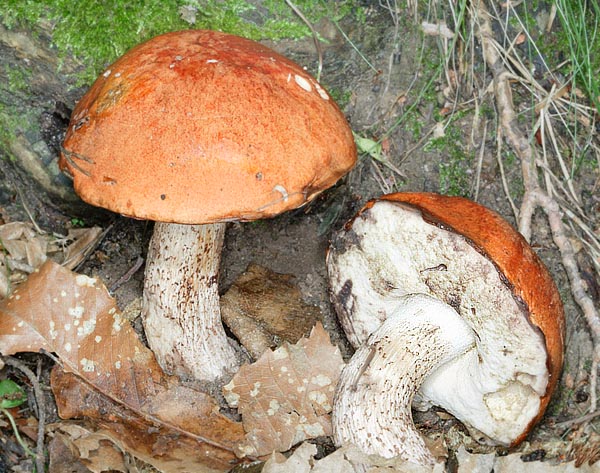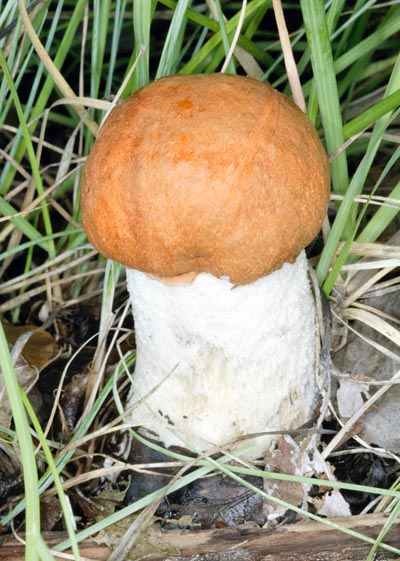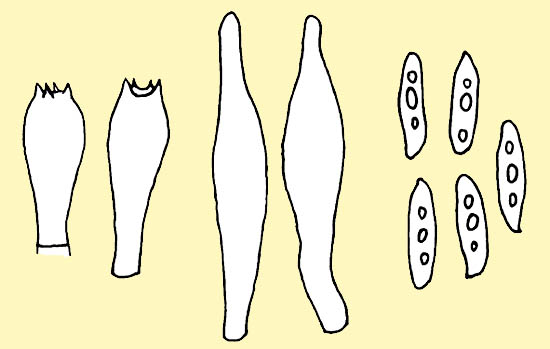
Text © Pierluigi Angeli

English translation by Mario Beltramini

The Leccinum aurantiacum is subglobose first, then hemispheric and almost flat when ripe © G. Mazza
Family: Boletaceae Chevall. 1828.
Genus: Leccinum S.F. Gray 1942.
Section: Leccinum S.F. Gray 1942.
Leccinum aurantiacum S.F. Gray 1821.
The etymology of the name comes from the Latin “aurántium” = orange, related to the colour of the oranges.
Description of the genus
The peculiar characteristics of this genus are: the stem, much slender, normally enlarged at the base and covered by more or less thick scales, at the beginning whitish, then blackish when old; the hymenophore formed by very thin and long tubules, rounded or free at the stem, detachable from the flesh of the cap, whitish, yellow or yellowish, grey or whitish-grey with very small pores concolorous to the tubules; the flesh, soft in the cap and fibrous in the stem, of white or yellow colour, staining when cut. The mushrooms belonging to this genus are all mycorrhizal. They are all edible, even if they are not all appetible.

Growing Leccinum aurantiacum © Giuseppe Mazza
Description of the species
Cap: 5-15 cm, initially sub-globose, then hemispheric, almost flat when completely ripe, margin initially adherent to the stem with a membranous edge, then appendiculate, frayed: the cuticle is adnate, velvety when young, then smooth, glabrous, rugulose, somewhat viscous in wet weather, feltered when the same is dry, of orange-red, fawn-red, more or less dark orange colour.
Hymenophore: long tubules, thin, free or rounded to the stem, from greyish-white to greenish-grey; small and round pores, of the same colour of the tubules and, like these ones, staining when cut or touched, to the brownish-grey.
Stem: 6-17 × 1,5-4 cm, cylindroid, slender, progressively attenuate at the apex, slightly enlarged at the base, full, firm, robust; white or whitish surface, covered by thick small scales of the same colour of the background which when ripe or touched darken to become brownish-red without becoming blackish, at times it may have some greenish spots at the base.
Flesh: thick, firm then soft in the cap, fibrous and hard in the stem, white, when cut or cooked turns quickly to the lilac-grey, then to the violet and finally to the black. Smell and taste are pleasant.
Habitat: it grows in summer and autumn under poplar and birch, often in numerous individuals.
Edibility: edible, only the cap is eaten, as the stem is hard and fibrous.
Spores: spindle-shaped, smooth, guttulate, 13,43-16,15 × 3,99-4,57 µm. Qm = 3,46; V = 142,94 µm3.
Basidia: clavate, with 2 to 4 sterigmata, without joint buckles, 24,2 – 29,7 × 8,8 – 11 µm.

Leccinum aurantiacum: basidia, cistydia and spores © Pierluigi Angeli
Cystidia: fusiform, numerous, at times with encrusted apex, 40,3 – 57,2 × 7,7 – 10,45 µm.
Cuticle: formed by parallel, more or less intertwined filamentous hyphae.
Remarks: it’s a mushroom easy to recognize, due to the orange-red colour of the cap and the growth under poplars.
It may be mistaken with the Leccinum vulpinum Watling, which, however, grows under conifer and, furthermore, has on the stem, blackish scales since young; the Leccinum quercinum Pilat & Dermek, which however has a more brownish cap, the small scales of the stem are fluffy, initially white, then brownish; the Leccinum versipelle (Fries) Snell, growing under birch, which has however a lighter cap with more yellow hues and the roughness of the stem are dark since the beginning.
Synonims: Boletus aurantiacus Bull. (1785) (basionym); Krombholziella aurantiaca (Bull.) Gilb. (1931); Boletus scaber var. aurantiacus (Bull.) Barla (1859); Krombholziella aurantiaca (Bull.) Maire (1937); Trachypus aurantiacus (Bull.) Romagensi (1939); Boletus rufus Schaeff. (1774); Boletus rufus Schaeff. : Krombh. (1821); Krombholziella rufa (Schaeff.) Alessio (1985); Gyroporus rufus (Schaeff. : Krombh.) Quélet (1886); Boletopsis rufa (Schaeff. : Krombh.) Henn. (1900); Boletus scaber var. rufus (Schaeff. : Krombh.) Persoon (1825); Tubiporus rufus (Schaeff. : Krombh.) Ricken (1918); Boletus scaber fo. aurantiacus Opat. (1836).
→ For general notions about Fungi please click here.
→ To appreciate the biodiversity of MUSHROOMS please click here.
